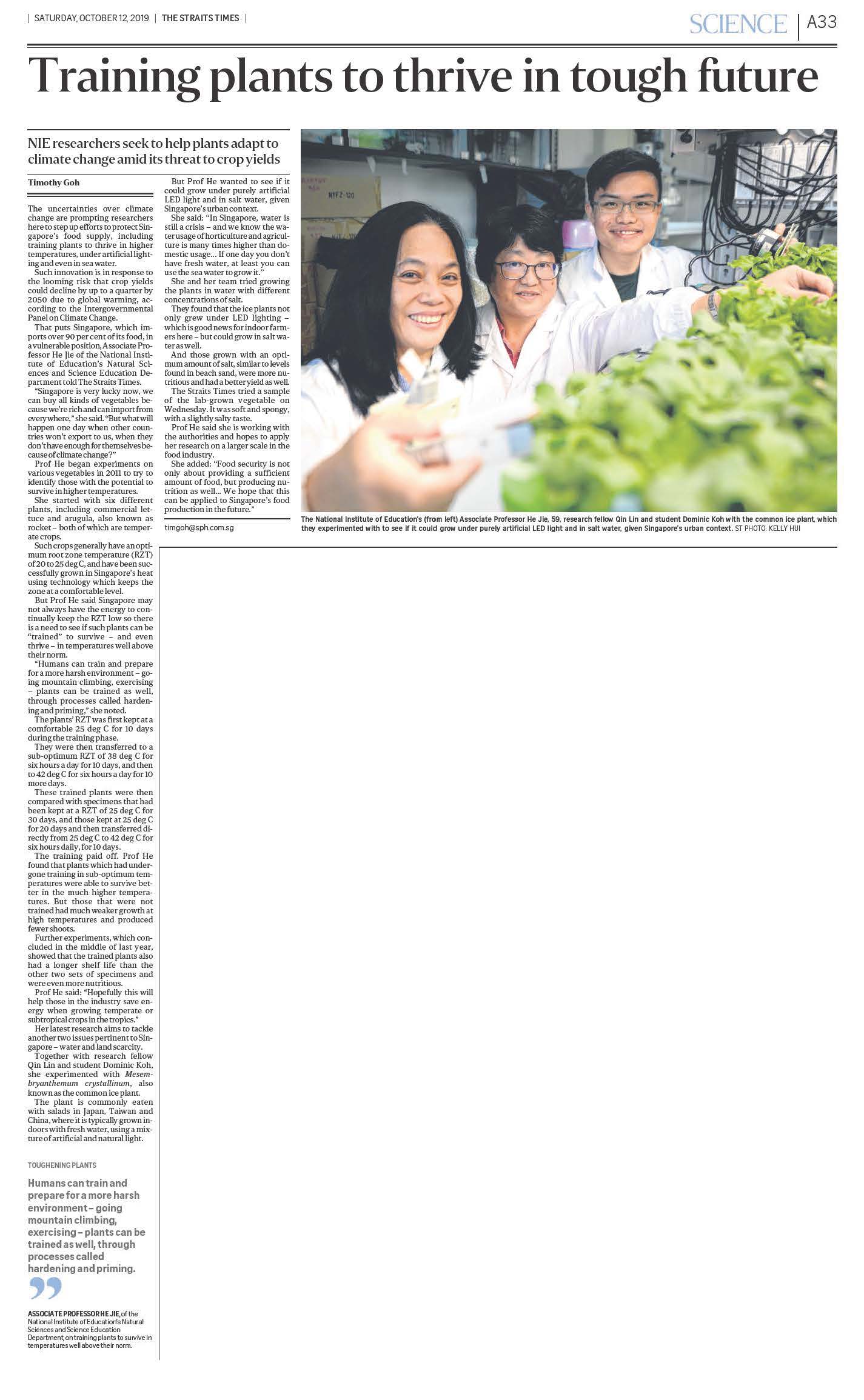Training plants to thrive in tough future

| SATURDAY, OCTOBER 12, 2019 | THE STRAITS TIMES
SCIENCE | A33
Training plants to thrive in tough future
NIE researchers seek to help plants adapt to climate change amid its threat to crop yields
Timothy Goh
The uncertainties over climate change are prompting researchers here to step up efforts to protect Singapore's food supply, including training plants to thrive in higher temperatures, under artificial lighting and even in sea water.
Such innovation is in response to the looming risk that crop yields could decline by to a quarter by 2050 due to global warming, according to the Intergovernmental Panel on Climate Change.
That puts Singapore, which im- ports over 90 per cent of its food, in a vulnerable position, Associate Professor He Jie of the National Institute of Education's Natural Sciences and Science Education Department told The Straits Times.
"Singapore is very lucky now, we can buy all kinds of vegetables be- cause we're rich and can import from everywhere," she said. "But what will happen one day when other countries won't export to us, when they don't have enough for themselves because of climate change?"
Prof He began experiments on various vegetables in 2011 to try to identify those with the potential to survive in higher temperatures.
She started with six different plants, including commercial lettuce and arugula, also known as rocket - both of which are temper- ate crops.
Such crops generally have an optimum root zone temperature (RZT) of 20 to 25 deg C, and have been successfully grown in Singapore's heat using technology which keeps the zone at a comfortable level.
But Prof He said Singapore may not always have the energy to continually keep the RZT low so there is a need to see if such plants can be "trained" to survive and even thrive in temperatures well above their norm.
"Humans can train and prepare for a more harsh environment-going mountain climbing, exercising plants can be trained as well, through processes called hardening and priming," she noted.
The plants' RZT was first kept at a comfortable 25 deg C for 10 days during the training phase.
They were then transferred to a sub-optimum RZT of 38 deg C for six hours a day for 10 days, and then to 42 deg C for six hours a day for 10 more days.
These trained plants were then compared with specimens that had been kept at a RZT of 25 deg C for 30 days, and those kept at 25 deg C for 20 days and then transferred directly from 25 deg C to 42 deg C for six hours daily, for 10 days.
The training paid off. Prof He found that plants which had under- gone training in sub-optimum temperatures were able to survive better in the much higher temperatures. But those that were not trained had much weaker growth at high temperatures and produced fewer shoots.
Further experiments, which concluded in the middle of last year, showed that the trained plants also had a longer shelf life than the other two sets of specimens and were even more nutritious.
Prof He said: "Hopefully this will help those in the industry save energy when growing temperate or subtropical crops in the tropics."
Her latest research aims to tackle another two issues pertinent to Singapore - water and land scarcity.
Together with research fellow Qin Lin and student Dominic Koh, she experimented with Mesembryanthemum crystallinum, also known as the common ice plant.
The plant is commonly eaten with salads in Japan, Taiwan and China, where it is typically grown in- doors with fresh water, using a mixture of artificial and natural light.
But Prof He wanted to see if it could grow under purely artificial LED light and in salt water, given Singapore's urban context.
She said: "In Singapore, water is still a crisis and we know the water usage of horticulture and agriculture is many times higher than domestic usage... If one day you don't have fresh water, at least you can use the sea water to grow it."
She and her team tried growing the plants in water with different concentrations of salt.
They found that the ice plants not only grew under LED lighting which is good news for indoor farmers here but could grow in salt water as well. And those grown with an optimum amount of salt, similar to levels found in beach sand, were more nutritious and had a better yield as well.
The Straits Times tried a sample of the lab-grown vegetable on Wednesday. It was soft and spongy, with a slightly salty taste.
Prof He said she is working with the authorities and hopes to apply her research on a larger scale in the food industry.
She added: "Food security is not only about providing a sufficient amount of food, but producing nutrition as well... We hope that this can be applied to Singapore's food production in the future."
timgoh@sph.com.sg
TOUGHENING PLANTS
Humans can train and prepare for a more harsh environment-going mountain climbing, exercising-plants can be trained as well, through processes called hardening and priming.
99 ASSOCIATE PROFESSOR HE JIE, of the National Institute of Education's Natural Sciences and Science Education Department, on training plants to survive in temperatures well above their norm.
(picture)
The National Institute of Education's (from left) Associate Professor He Jie, 59, research fellow Qin Lin and student Dominic Koh with the common ice plant, which they experimented with to see if it could grow under purely artificial LED light and in salt water, given Singapore's urban context. ST PHOTO: KELLY HUI



_jingyu-wang.tmb-listing.jpeg?Culture=en&sfvrsn=4127a7de_1)
.tmb-listing.jpg?Culture=en&sfvrsn=15e6d6d7_1)
.tmb-listing.jpg?Culture=en&sfvrsn=b13552ed_1)

